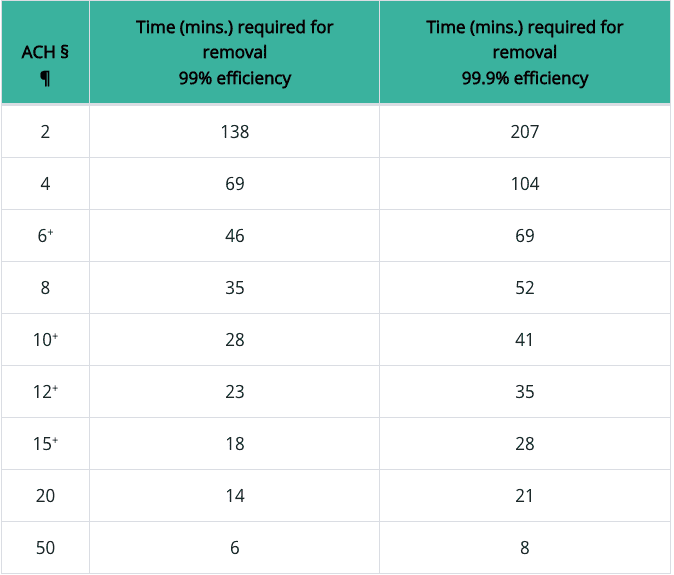Whether you want to remove air pollution, surface contaminants, or eliminate pet dander, dust, and odors, an air scrubber is a perfect device for the job. An air scrubber is useful not only for remediation projects but also for use on construction sites, and in the healthcare industry.
However, before you invest in an air scrubber, you need to calculate the total cubic feet of your space. You also want to determine the number of “air changes” required per hour to choose the right unit for your space.
If it’s your first time buying an air scrubber, you must have a sufficient understanding of cubic feet per minute (CFM) and air changes per hour (ACH).
Keep on reading to learn everything you need to know about ACH and CFM to make an informed decision.
Table of Contents
What Does CFM Mean?
As mentioned above, CFM refers to “cubic feet per minute” an air scrubber covers when cleaning or purifying the air of the space. Basically the volume of air moving through the machine. The CFM of an air scrubber is typically listed on the sales page.
Though a unit can have a high CFM, that doesn’t necessarily mean it is better at cleaning the air than a lower CFM unit. The quality of the filtered air depends on the filters that are used. CFM is just an indicator for how much air is moving through the unit.
What's a Good CFM?
So now the question is what CFM should my air scrubber have?
To determine the ideal CFM of your air scrubber, first calculate the volume of the space in feet. For a rectangular room this would be the length x height x width.
Once you have the volume in feet you can then determine how many air changes per hour (ACH) are required for your use case. To determine the required ACH refer to the chart below. At minimum you should aim for at least 4 ACH. Once you have these two values, the volume in feet and the required ACH, you can calculate the CFM your air scrubber will need.
How To Calculate CFM
The formula to calculate required CFM is “(Room Volume in feet) x (ACH) / 60 min.
What does ACH Mean?
ACH refers to ‘Air Changes Per Hour’.
This is the number of times your air scrubber filters air in the space per hour.
One ACH means the air scrubber filters all the air in your space once per hour.
How Long Does It Take For An Air Scrubber To Work?
So you may be wondering, how long will it take the air scrubber to clean the air in my space. Luckily, the CDC has already done research in this area.
The following chart is provided by “Guidelines for Environmental Infection Control in Health-Care Facilities (2003)”cdc.gov, CDC, https://www.cdc.gov/infectioncontrol/guidelines/environmental/appendix/air.html . May-29-2022

So according to the chart, if you have 4 ACH, 99% of the contaminants will be removed after 69 minutes.
Keep in mind these numbers only apply if your air scrubber is equipped with a HEPA filter and no more contaminants are being generated while the air scrubber is running. Nevertheless, this should give you an idea of how long it will take to remove a contaminant from the air.
How To Calculate ACH
To calculate ACH, you need two numbers;
CFM
Room Volume in feet ( For a rectangular room this would be height x width x length)
Once you know these values, you can calculate air changes per hour by applying this formula:
ACH = CFM x 60/ Room volume
Recommended ACH Levels
The ACH you need depends on your use case. Check out the chart below for recommendations.
The following recommended ACH levels are taken from Engineering ToolBox, (2005). Air Change Rates in typical Rooms and Buildings. [online] Available at: https://www.engineeringtoolbox.com/air-change-rate-room-d_867.html 05-25-2022.
Building / Room | Air Change Rate – n – (1/h) |
All spaces in general | min 4 |
Barber Shops | 6 – 10 |
Bars | 20 – 30 |
Beauty Shops | 6 – 10 |
Classrooms | 6 – 20 |
Cocktail Lounges | 20 – 30 |
Dining rooms (restaurants) | 12 |
Factory buildings, with fumes or moisture | 10 – 15 |
Garages repair | 20 – 30 |
Kitchens | 15 – 60 |
Nightclubs | 20 – 30 |
Machine shops | 6 – 12 |
Medical Centers | 8 – 12 |
Offices, private | 4 |
Paint shops | 10 – 15 |
Residences | 1 – 2 |
Restaurants | 8 – 12 |
Retail | 6 – 10 |
Shops, woodworking | 5 |
Supermarkets | 4 – 10 |
Theaters | 8 – 15 |
Warehouses | 2 |
For the full list visit The Engineering Toolbox.
What is CADR?
CADR stands for a “Clean Air Delivery Rate”. It is AHMA’s standard to measure the efficacy of air purifiers.
Note that CADR doesn’t apply to commercial air scrubbers, at the moment it only applies to residential air purifiers.
CADR takes CFM and filter efficiency into account and allows for quick comparisons between different air purifiers. The higher the CADR, the better.
CADR is broken down into different scores for dust, pollen, and tobacco smoke.
AHMA’s methodology for calculating CADR is a little too technical to go over on this site, but if you’re curious you can check out the report listed on AHMA’s site.
If you’re interested in residential air purifiers that have been tested for CADR you can check out our lists of the best Bissell, levoit, and medify air purifiers.

I do the research so you don't have to.

